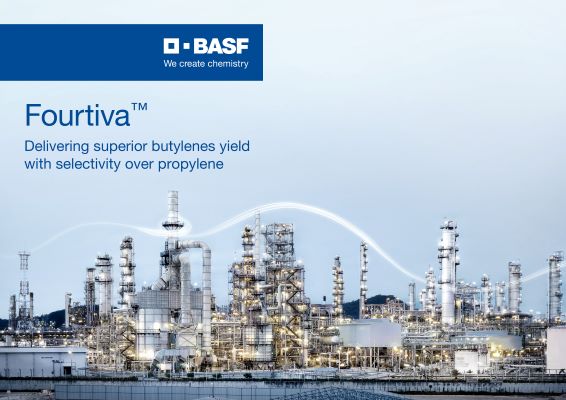Optimized to maximize butylene yields and selectivity while improving naphtha octane, LPG olefinicity and minimizing coke and dry gas

BASF's Fourtiva FCC catalyst helps refiners to produce more valuable products, increase profitability and reduce the carbon footprint of the FCC unit.
BASF announced the commercial launch of Fourtiva, a new Fluid Catalytic Cracking (FCC) catalyst for gasoil to mild resid feedstock.
Fourtiva incorporates BASF’s newest Advanced Innovative Matrix (AIM) and the Multiple Frameworks Topology (MFT) technologies to achieve an optimized catalyst design to maximize butylene yields and selectivity over propylene while improving naphtha octane, LPG olefinicity and minimizing coke and dry gas. This helps refiners to produce more valuable products, increase profitability and reduce the carbon footprint of the FCC unit.
BASF’s Fourtiva selectively incorporates AIM and MFT technologies into the catalyst design to meet a broad range of performance targets and applications. The AIM technology enhances the performance of the FCC catalysts through the optimal matrix acidity and activity, improved pore size distribution, and matrix-zeolite interaction to enable coke selectivity. Combining AIM technology with MFT technology creates a unique catalyst which can help refiners improve margins and provide the operating flexibility needed to quickly react to market changes.
“Commercial trials have confirmed the ability of Fourtiva to deliver superior economic performance which helps refiners increase their profitability,” said Detlef Ruff, Senior Vice President process catalysts at BASF. “The creative combination of BASF’s AIM and MFT technologies make Fourtiva a great example of our innovative spirit and dedication to substantially add value for our customers.”
“BASF continues to rapidly respond to customers’ needs,” said Alex Attlesey, Vice President refining catalysts at BASF. “Our customers gave us the feedback that they needed a catalyst to maximize butylene yields and selectivity. Fourtiva directly addresses this need by helping them to maximize high octane gasoline blending feedstock.”
Subscribe to our newsletter & stay updated.